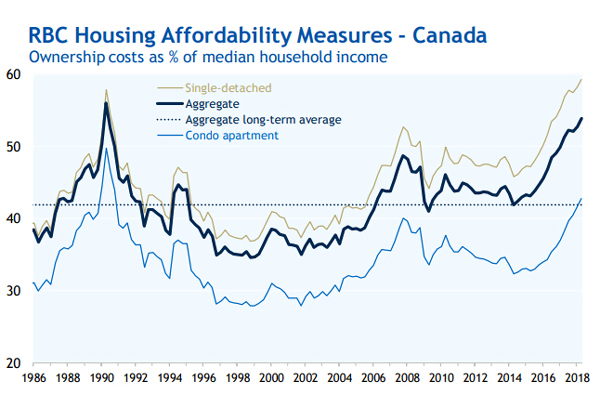
September 28, 2018
West Shore Voice News
“Unaffordability is off the charts in Vancouver, Toronto and now Victoria,” says RBC in their September 2018 Economics Research report, saying the affordability measure hasn’t been this bad since 1990. Ownership costs to carry a home bought in the second quarter of 2018 would have taken up 53.9% of a typical household’s income. This is up sharply from 43.2% three years ago. Their conclusion about housing ‘unaffordability’ should come as a surprise to no one.
Banks have traditionally required a 30% cap on home ownership costs as a percentage of household income. Spending more than 30% on home ownership (or rent for that matter) has long been situation for many in the Greater Victoria area. The burden of that is only now reaching broad awareness in the mainstream because even families with two incomes can’t often qualify for a mortgage.
News last summer/fall 2017 about the pending stress test spooked buyers and banks, even then starting to ‘cool the market’. The Bank of Canada admitted well before the January 1, 2018 stress test start date that the measure would likely shut out 10% of low-ratio home buyers.
First time-buyers now often end up in the higher-end of the glutted rental market where they essentially take up room that the regular renter market needs, and also diminishes their ability to save up to put a downpayment on a home. This socioeconomic sector is still motivated to try hard… they’ve often got new businesses or young families, and may still have stars in their eyes for a full and successful life ahead of them.
Squeezing this group makes no socioeconomic sense. It can crush people, serving to diminish their enthusiasm on all sorts of levels. A smart economy will seek the verve of the ‘up and coming’. Suppressing young families and talent within the workforce – by diminishing their basic housing security – is starkly counter-productive to a healthy society and robust economy.
RBC’s conclusion in their September 2018 report? “It’ll probably get worse. We expect further interest rate hikes in the period ahead. This is poised to drive ownership costs even higher across Canada. Household income increases will soften the blow for buyers.” It’s unclear how household income is expected to increase anywhere close to the rate of rising housing costs.
Nowadays for many individuals and families it’s put a roof over your head and then see what’s left for everything else. It sets up an underlying tone of desperation (not good for productivity or for holistic relationships in families and community). Depending on life circumstances (sometimes unforeseen), homelessness can easily lurk in the shadows for anyone.
Victoria Real Estate Board statistics for August 2018 show
the single family home average sale price as $937,459 for Greater Victoria overall. In the west shore, average sale prices in August were somewhat lower compared to a few months ago (i.e. ‘market cooling’): Langford: $708,970 (had been in the $772,000 range earlier this year); Colwood: $727,447; Sooke: $446,065 (had been well over half-a-million at points earlier this year).
The present scenario is hopefully a loud wake-up call that continued attention to the housing crisis should be the primary concern for all levels of government, including municipal (where land zoning happens), provincial (housing falls directly under their watch), and federal (for a national strategy).
This crushing reality in the housing market is coupled with regularly increasing rental rates (the rate was 4.0% in BC for this year, but is being held to the rate of inflation at 2.5% for 2019).


